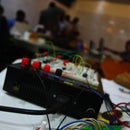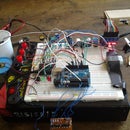Introduction: DIY: Door Alarm System Using the Arduino Uno
This is a door alarm system which can be easily built and installed. It uses the basic principle outlined by the Arduino Uno Designers that is to use the Sensor, Microcontroller and the Actuator. In this design the sensor is the Hall-effect device (A1324) together with a permanent magnet (or you can use your own electromagnet), the micro-controller is the ATmega 328 embedded in the Arduino Uno and lastly the actuator is a 8ohm speaker used with a 555 timer and a optocoupler. It can be powered
using the5V power supply of the Arduino Uno. It is highly sensitive, low cost and easy to construct and install.
Arduino Uno or any version of Arduino
Hall effect device (A1301, or A1324 or A1325)
Optocoupler (4N25)
555 Timer
Permanent magnet (electromagnet)
Diode (1N4007)
220ohm and 1kiloohm resistors
8ohm speaker
5V power supply (or any below 12V)
Connecting cables
Prototyping board
0.1 microfarad and 10microfarad capacitor
using the5V power supply of the Arduino Uno. It is highly sensitive, low cost and easy to construct and install.
Arduino Uno or any version of Arduino
Hall effect device (A1301, or A1324 or A1325)
Optocoupler (4N25)
555 Timer
Permanent magnet (electromagnet)
Diode (1N4007)
220ohm and 1kiloohm resistors
8ohm speaker
5V power supply (or any below 12V)
Connecting cables
Prototyping board
0.1 microfarad and 10microfarad capacitor
Step 1: Positioning the Sensors
Grab a long cable with three wires inside, solder the Hall device to the ends of the cable taking note of the color code. Get to your door and open it. Find a way of attaching the Hall device and the magnet such that when the door opens the magnetic field strength being sensed by the Hall device decreases
Step 2: Wiring
Wire from your door to your workstation
Step 3: Get the Cable to Your Work Station
With the cable to your work station you can do whatever your want
Step 4: Welcome Arduino Uno
Having the data cable with you, grab the Arduino Uno and do some wiring according to the Circuit diagram provided.
Step 5: Sketch
Time for some coding
int const opto = 2;
int const sensor = A0;
const float controlVal = 600;
void setup(){
pinMode(opto, OUTPUT);
pinMode(sensor, INPUT);
Serial.begin(9600);
}
void loop(){
int sensorVal = analogRead(sensor);
int mapped = map(sensorVal, 510, 560, 1023, 0);
if (mapped >= controlVal){
digitalWrite(opto, HIGH);
}
else {digitalWrite(opto, LOW);
}
delay(100);
}
int const opto = 2;
int const sensor = A0;
const float controlVal = 600;
void setup(){
pinMode(opto, OUTPUT);
pinMode(sensor, INPUT);
Serial.begin(9600);
}
void loop(){
int sensorVal = analogRead(sensor);
int mapped = map(sensorVal, 510, 560, 1023, 0);
if (mapped >= controlVal){
digitalWrite(opto, HIGH);
}
else {digitalWrite(opto, LOW);
}
delay(100);
}
Step 6: Components Together
Assemble the components on a bread board, taking consideration on the pins of the 555 timer, opto-coupler and Arduino Uno
Step 7: Door Open and Door Closed
Run a test with the door open and with the door closed. You can control the sensitivity with the controlVal in the Arduino Sketch
Step 8: Last Touch
After getting it to work you can then do whatever you want with it. You can improve on the sound quality, sensitivity, housing or even add more components to make it nicer. Cheers!!!










